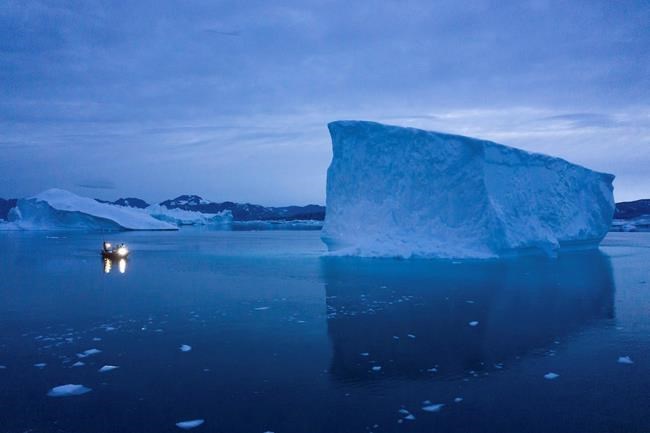
In this Aug. 15, 2019, photo, a boat navigates at night next to large icebergs in eastern Greenland. Greenland's ice has been melting for more than 20 years. THE CANADIAN PRESS/AP-Felipe Dana
Republished April 28, 2021 - 2:13 PM
Original Publication Date April 28, 2021 - 11:01 AM
A new study has used millions of satellite images to generate the clearest picture yet of the world's glaciers and concludes they're getting smaller, faster.
And glaciers along the western edge of North America are thinning faster than almost anywhere else in the world, said co-author Brian Menounos of the University of Northern British Columbia, whose paper was published Wednesday in the journal Nature.
"I don't think humans need more evidence the climate is changing," Menounos said.
"But I also think we can't throw up our hands and say, 'Oh, we can't do anything.' We have to understand the implications of climate change."
Scientists have long known that the world's 217,000 glaciers are in retreat.
That knowledge, however, was based on relatively infrequent satellite images and field monitoring that didn't include all glaciers. Menounos and his colleagues turned to a previously unused trove of images that allowed them to estimate the falling elevation of precise spots with unprecedented accuracy.
"We had (a supercomputer) running for a solid year of compute time," he said.
Once they knew how far the surface of the glaciers had fallen, they could calculate how much ice was lost. The results boggle the mind.
They found glaciers are now losing 267 billion tonnes of ice every year. Just one billion tonnes of ice — a gigatonne — is equal in mass to 10,000 fully loaded aircraft carriers.
Put another way, that's enough ice melting every year to cover Canada's entire land mass to a depth of 30 centimetres.
The pace is picking up. Between 2000 and 2004, when the study begins, glaciers "only" lost 227 gigatonnes per year.
But glaciers up the mountainous western spine of North America — including Canada — are melting even faster. Their thawing rate increased fourfold between 2000 and 2019.
Glaciers are now responsible for about 21 per cent of the roughly 22 centimetres that sea levels have risen since 1880.
That won't stop. By the end of the century, about 200 million people will live on land likely to be submerged at high tide.
Glaciers are also a crucial source of fresh water, as they are in Western Canada. The paper quotes research suggesting more than one billion people could face water shortages by 2050.
That doesn't include other benefits humans rely on glaciers for. They keep headwaters streams cool, for example.
"If you take that thermal buffering capacity of glaciers away, you're left with a situation where these aquatic ecosystems are going to change," Menounos said.
By far the biggest driver of glacial melt is rising temperatures caused by climate change, said Menounos. There are enough greenhouse gases in the air that some melting will continue even if the taps were turned off tomorrow.
But he said his study shows that while humans are causing the problem, they can also curb it.
"We just need the power and the gumption and the willpower to make some hard, difficult decisions," Menounos said.
"You can't really engineer your way out of this problem. You have to mitigate and reduce greenhouse gas emissions."
This report by The Canadian Press was first published April 28, 2021.
— Follow Bob Weber on Twitter at @row1960
News from © The Canadian Press, 2021